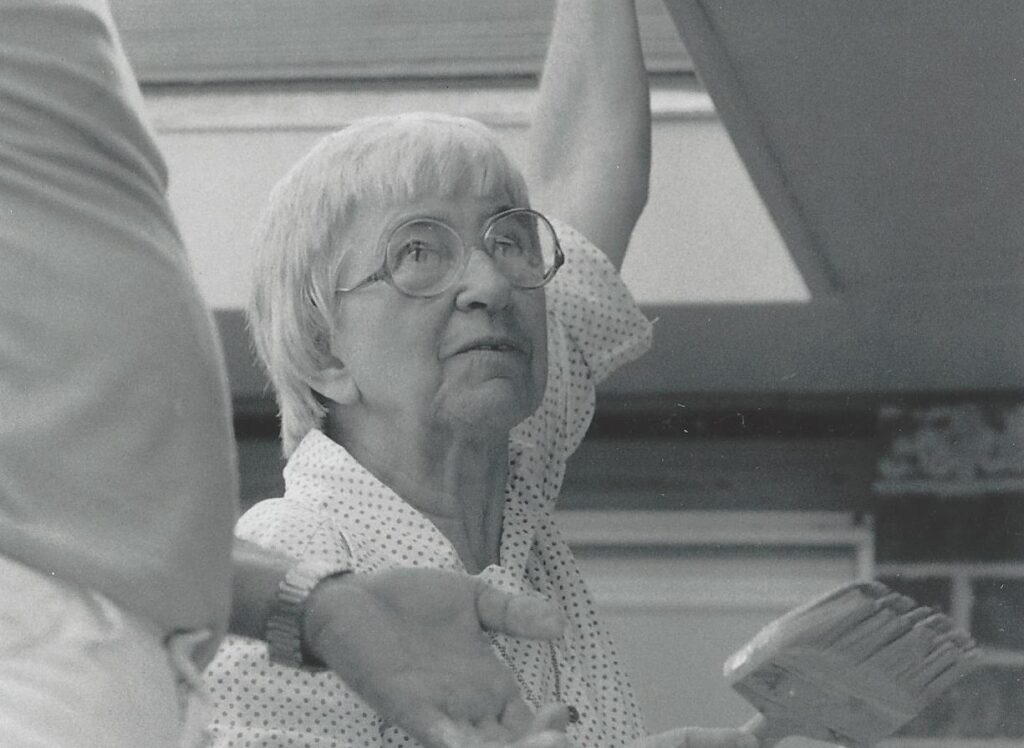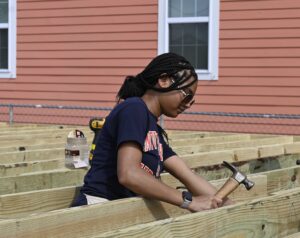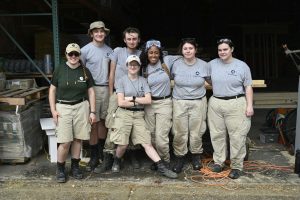Eleven years ago, in the wake of Hurricane Katrina, more attention than ever was focused on housing in New Orleans. Many who had never before heard of New Orleans Habitat became aware of our work, especially as our output amplified in response to the increased need for decent, affordable housing. NOAHH, however, was founded 33 years ago, 22 years before the storm. As we reflect on the changes that we’ve experienced since the storm, we want to share the story of how our affiliate started.
Improbably, it started in Covington. Improbably, it started twice. Most improbably, it started on a winter watersports daytrip:
The day after Thanksgiving in 1982, Marilyn Wenzel and Sister Mary Grace Stelly drove to the North Shore to go waterskiing on Lake Pontchartrain with a group from their church. While on that side of the lake, at the suggestion of Sister Mary Grace, they stopped at a Habitat for Humanity home dedication in Covington.
In front of a newly-built home, near the refreshment table, Sister Mary Grace and Marilyn took in the scene while a singer from The Abbey serenaded. In that moment, inspired by the atmosphere of support in the crowd, Sister Mary Grace suggested to Marilyn that they should start a Habitat for Humanity affiliate in New Orleans. Her timing was exemplary—not only did Marilyn agree, but it would turn out that Sister Mary Grace and Marilyn were not the only people planning to bring Habitat to the city.
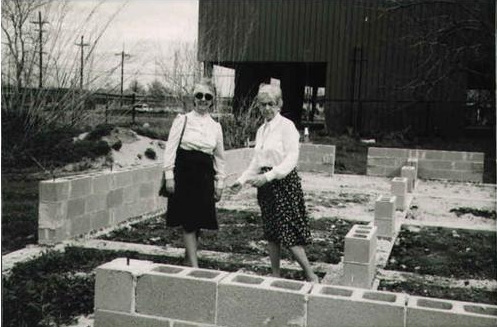
On another day, in a Covington living room, unknown to Sister Mary Grace and Marilyn, three friends—Holly Hess, Katie Robinson, and Jerry Heatherly—met to discuss starting an affiliate. Despite their different denominations (Presbyterian, Baptist, and Church of Nazarene, respectively), they determined that the best way to put their faith into action would be to start their own Habitat for Humanity affiliate.
Although Habitat for Humanity was still young in the world of non-profits (only seven years old), the New Orleans founders thought that the organization’s model could help alleviate local housing issues. Eventually, these two groups connected and applied to start an affiliate together. Six months after Sister Mary Grace and Marilyn first discussed the idea, Holly and Katie went to present their application to the Habitat for Humanity main office. Along with Harry Eskew, a Baptist minister, the two groups founded New Orleans Area Habitat for Humanity.
After a few board meetings at a public school, it became clear that the Board of Directors would not be a conventional one. In many ways, Sister Mary Grace is emblematic of that unique founding board.
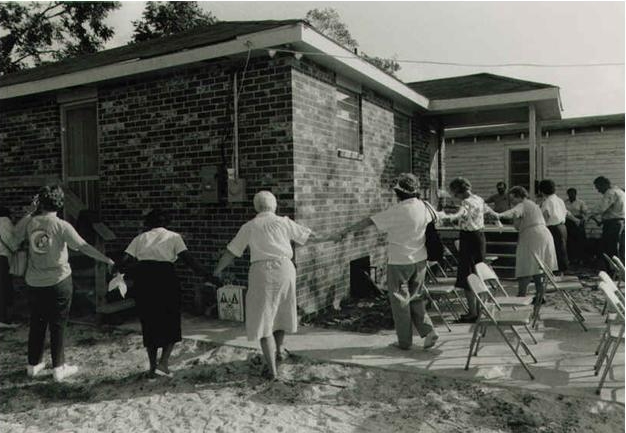
Sister Mary Grace Stelly
As the crowd dispersed following a Mardi Gras parade in the late 1960s, a herd of boys sprinted down Magazine Street. Startled by the swiftly-moving pack, people backed away nervously. The boys crowded around a group of nuns on the sidewalk, surrounding Sister Mary Grace. While bystanders looked on with apprehension, the group of formerly-intimidating boys started to shower her in beads. A smile filled her face, and she laughed. The boys kissed her cheek and ran away.
At the time, Sister Mary Grace was a social-justice advocate in New Orleans. Before joining the Eucharistic Missionaries of Saint Dominic in 1941, she was a teacher in a school near Lake Charles. Given her teaching background, leaders of her church urged her to gain a masters in theological studies, which she received from the University of Notre Dame. She then took her teaching skills to the convent.
“When I came to the convent in 1961, she was our teacher for the New Testament,” Sister Jeanne Moore, who has served the church since 1964, said. “We would stay up real late studying. We would take turns being awake. She was there to teach us about the New Testament, and, by God, we learned.”
Those who knew Sister Mary Grace described her as hard-working, determined, and passionate about what she believed in. Her devotion to bringing change to the world meant she was usually found working or praying, and, as her friends affectionately recalled, she would often catch people in long conversations about the social issues she was advocating for, fighting against, or otherwise involved in. Though she spent 20 years teaching the Bible to new students, her passion eventually drove her to leave teaching to work directly in the community.
“She just saw that education alone isn’t enough,” Sister Jeanne said. “You have to start breaking structures.”

After she left the school, Sister Mary Grace started an organization called Saving Ourselves (SOS) for young people in the community who were at risk of getting into legal trouble. Her friends said that she often seemed to be seen as a grandmother to most of the boys in the communities she served, and that she saw the best in them. Unlike those around her, witnessing a crowd of young men rush toward her in the streets after a Mardi Gras parade was cause for joy, not alarm.
Sister Noël Toomey warmly recalled, “Sister Mary Grace was like the person in the Gospel who goes to their neighbors’ house and bangs on the door saying ‘I need something to eat.’ She wouldn’t keep quiet and finally they have to feed her.”
Her persistence, however, wasn’t in asking for her own food, but in finding people to help her community and her organizations. Her friends said she expected this attitude from everyone she knew.
Her beliefs in direct involvement, her untiring hard work, and her commitment to New Orleans helped shape NOAHH in the early days. As one of the longest-serving members of the original board, Sister Mary Grace played a large part in NOAHH’s beginnings. Although she did not often work at the build sites like most other board members, she was always making phone calls and connecting with people in the community to help the affiliate. She met often with mayors, district attorneys, and business-people to build support and secure resources for the causes she was passionate about. If NOAHH needed an electrician, Sister Mary Grace and Marilyn would find one. If NOAHH needed lumber, Sister Mary Grace and Marilyn would acquire it. If NOAHH needed volunteers, donations of property, or a venue for their next event, Sister Mary Grace and Marilyn were there and ready to help.
“Sister Mary Grace was an advocate morning, noon, and night,” Jeanne said. “She was always on the side of the underdog.”
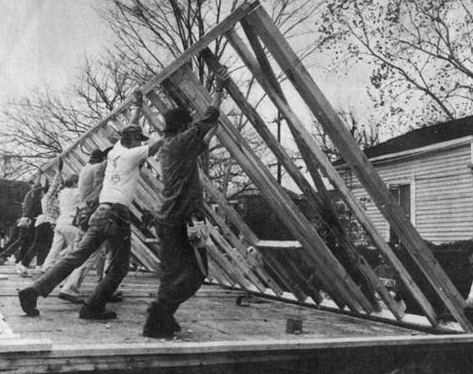
The Early Years
“We met regularly. We were successful in getting donations of properties, and we started to grow,” Marilyn said.
The board was instrumental in the affiliate’s early years, being involved in every aspect of the mission. Beyond just fundraising and organizing, they helped with home construction.
“Somewhere in all of those homes, my amateur building skills are represented,” Holly said, in reference to homes built in the 1980s. “Our work was dependent on what needed to be done and how much money we had.” The fewer resources the affiliate had, the more work board members stepped up to do.
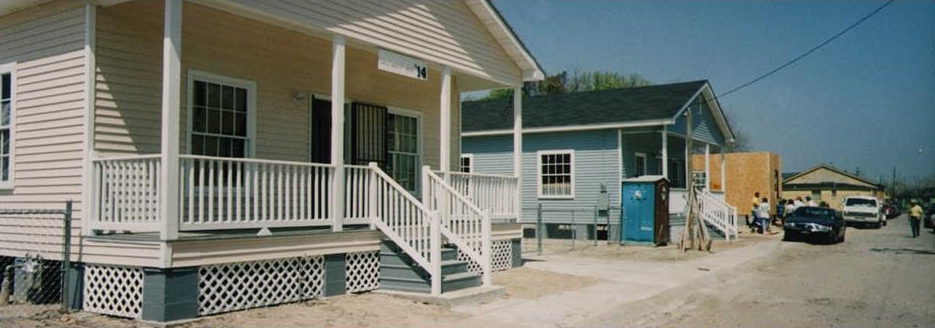
Often working on build sites to paint, roof, and lay the foundation, they did what needed to be done to build homes. They often worked on homes after work, served on committees, and organized events to promote the affiliate.
Harry Eskew, who was on the family selection committee and often interviewed potential Habitat homeowners, employed his wife, Margaret, to write the Habitat Hammer newsletter for five years.
“Everybody on the board was a member of one committee or another,” said Lonell Wright, who joined NOAHH in the early 1990s and soon became board president. “We didn’t bring anyone home who was not going to be involved or not going to be committed. Habitat thrives on people who are going to be committed, who are going to give up their time and their voices.”
This was echoed by Holly, who recalled that once, after working until 5 p.m., she met Marilyn at a house on Flood Street to paint a home.
“You had to do what you had to do to get the project done,” Holly said.

At a home-build in the Uptown area, she met up with a group of staff members and volunteers, listening to music while standing in the scaffolding of a house, scraping paint off the walls.
“It was a fledgling board,” Marilyn, who was the chairman of the Building Committee and on the board for 8 years, said. “We built two houses, and it was difficult, driving back and forth. One time, it was so hot that I almost fainted at night after work.”
Marilyn would find groups of people, especially from companies with a local presence, to come in as volunteers. Despite having fewer staff and longer build times, NOAHH’s work was carried out with huge amounts of support from volunteers in the community. AT&T, Trinity Church, First NBC, and McDonalds often gathered many volunteers to work with NOAHH. Sometimes there would be as many as 100 volunteers out on build sites, considerably more than typical for most affiliates in those days. Regardless of the number of volunteers, the Board of Directors still had to put in extra time in building homes, sometimes after hours, to finish on schedule.
Though Sister Mary Grace passed away in 2000, her spirit of service has echoed and amplified as NOAHH continues her legacy. Over 30 years later, NOAHH still has an active and engaged Board of Directors who work closely with affiliate staff to further our mission, and most board members find time to volunteer on site—though now it’s rarely after work hours. As the affiliate has grown and needs have changed, the Board of Directors has changed to meet those needs. What the founders created has become bigger than they expected, but without their hard work and inspiring example in the early years, the affiliate never would have risen to the challenges presented by the storm and continued to adapt in the years to come.
